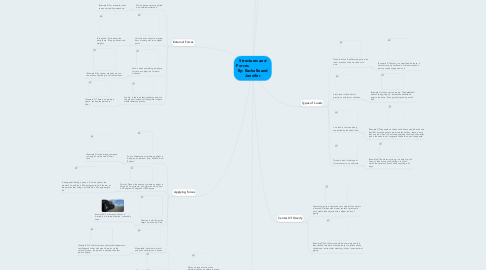
1. Internal forces
1.1. Shear is a type of action that breaks or causes an object to break in half.
1.1.1. (Example 2) The person is applying shear, to the pencil so it breaks in half, because they are mad.
1.2. Torsion is an action of twisting an object.
1.2.1. (Example 2) The girls hair is straight, but some part of her hair is twisted. This can be shown for style.
1.3. Tension is when an object is stretched or is being stretched so it can expand, or move in a certain direction.
1.3.1. (Example 2) The kids are fighting for the toy. They are pulling on both sides. At some point the object will break in half. Or it may expand.
1.4. Compression is a force on an object being pushed or compressed together.
1.4.1. (Example 2) In this image a springier is being compressed together by force, from a person.
2. Applying forces
2.1. Point of Application is where an object is being hit, or touched. (Top, Middle, And Bottom)
2.1.1. (Example 2) In this image, someone is being hit on the side of their face.
2.2. Point of Plane is the degree of where an object is being hit. For instance, an object can be hit from a 90 degree, 45 degree or 180 degree
2.2.1. A dodge ball hitting a person. If it aims right at the stomach it would be a 90 degree angle hit. If the aim at the persons feet of legs, it would be a 45 degree angle hit.
2.3. Direction is which way the object is moved by force.
2.3.1. (example 2) For instance, the car is moving in a forward direction, caused by force.
2.4. Magnitude is how hard or soft you push an object so it moves.
2.4.1. (Example 2) In the first picture, the football players are tackling each other, with great force, but in the second picture, the person is pushing the other person lightly.
3. External Forces
3.1. Pull is when an object is pulled in a backwards direction.
3.1.1. (Example 2) For example, when someone is pulling weeds up.
3.2. Lift is when an object is moving from a lower point to an higher point.
3.2.1. (Example 2) For instance the people are lifting up boxes and weights.
3.3. Push is when something applies a force to an object in a forward direction.
3.3.1. (Example 2) As shown, everyday we use the action of pushing to our convenience.
3.4. Gravity is the force that pushes us down to the ground, instead of floating like in space where thereis no gravity.
3.4.1. (Example 2) There is no gravity in space, causing the person to float.
4. Form, purpose, and function
4.1. Purpose is why the structure was made and what it was made for.
4.1.1. (Example 2) A hospital is made to cure sick patients.
4.2. Function is the job a structure is designed do.
4.2.1. (Example 2) A sink is made to have water come out of it to wash people's hands.
4.3. Form is a structure's basic shape
4.3.1. (Example 2) A desk's basic form is made of a frame which is the legs, and is solid because it carries lighter objects, and can't break easily.
5. Center Of Gravity
5.1. Center of gravity is where the most weight of an object is located. Objects with a lower center of gravity are more stable then objects with a higher center of gravity.
5.2. (Example 2) The taller car would tip over more easily if they crashed into each other, because it is taller and the shorter one is also wider meaning, it has a lower center of gravity.
6. Type of sturctures
6.1. Shell structures are hollow, strong, and light weighted for it's size.
6.1.1. (Example 2) The nest is a home for birds, and is strong, light and perfect for a birds size.
6.2. Solid structures are solid throughout no matter what.
6.2.1. (Example 2) For instance a house is designed to hold people and other things in different weathers.
6.3. Frame is a structure like a skeleton that is put together to support something.
6.3.1. (Example 2) A hockey net is a frame structure because the frame of the net is what supports the net, and without the frame the net cannot be held as a hockey net.
7. Types of Loads
7.1. Dead load is a load that supports a live load, and cannot be moved on it's own.
7.1.1. (Example 2) The chair is a dead load because, it cannot move by itself and a live load such as a person can be supported on it.
7.2. Static load is the effect of gravity on a object or structure.
7.2.1. (Example 2) when a person shoots. The basketball doesn't keep going up. Instead the basketball goes in the hoop. Since gravity is pushing on the ball.
7.3. Live load is the load being supported by the dead load.
7.3.1. (Example 2)The people on the hot air balloon would be the Live load.But since the people are inside the balloon, there is more than one load. And it is not the people by them self, the basket part is the dead load, it supports the balloon, and the people.
7.4. Dynamic load is the type of forces that act on a structure.
7.4.1. (Example 2) The water is strong. It is able to push down or take house and buildings. In other words the water will, knock down anything in its ways.

